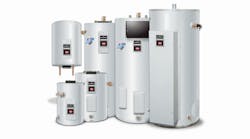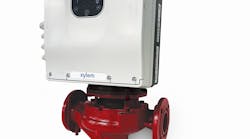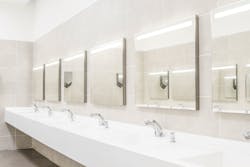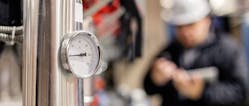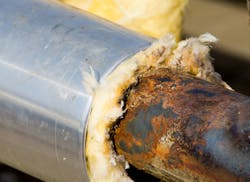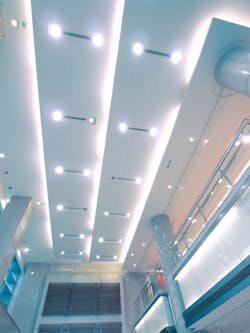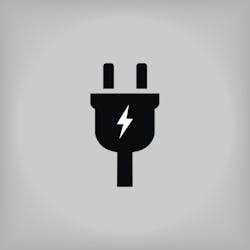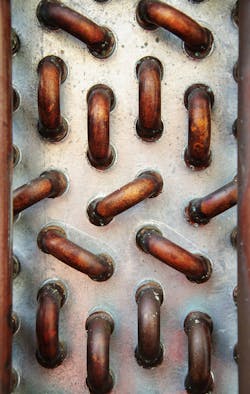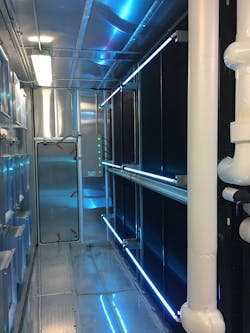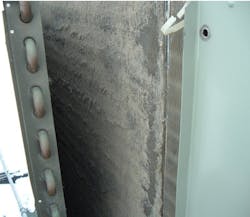While new buildings present opportunities for energy-conscious design, existing buildings present ones for low- and no-cost energy-saving retrofit measures. Here are some ideas.
Analyze Building Energy Use
Understanding how a building uses energy (heating, cooling, lighting, process loads, etc.) can be a useful step toward identifying ways to use energy more efficiently. Large consumers might require only small changes or improvements for significant savings to be achieved. At the same time, smaller users should not be overlooked—a little here and a little there can add up. The article “Analyzing Building Energy Use”1 presents a simple technique for using utility bills and weather data to analyze building energy use.
Reduce Water Pressure, or Use Low-Flow Faucets and Showerheads
This popular measure goes back many years, but is it always smart?
Low-flow faucets save water (and energy for heating hot water), if people are given to leaving the tap on while brushing their teeth or shaving. Should the focus be on making wasteful practices less wasteful, or should it be on changing the behavior behind the wasteful practices?
Low-flow faucets do not save water or energy on tasks requiring a certain volume of water, such as filling a washing machine or bathtub. Low-flow faucets also do not reduce the amount of water needed for such tasks as rinsing soapy hands; they just aggravate the user and, if the stream is particularly weak, might even lead to more water use. Waiting even an additional two or three seconds to fill cupped hands with enough water to rinse a soapy face can seem like an eternity.
Low-flow showerheads are controversial. Many provide too little coverage, making the user “do a dance” to rinse thoroughly. Others spray water with force insufficient to rinse shampoo from a full head of hair; water has a discernible downward arc as it leaves the showerhead. And then there is the question of whether a shower provides the user’s desired tactile experience.
The amount of water low-flow showerheads actually save is unclear. Some say users compensate for low flow by taking longer showers. An independent Maximum Performance (MaP) research report2 questions the magnitude of that effect, but acknowledges water savings might not be huge. If water savings are not substantial, why not give users the satisfaction they desire? Perhaps users are more inclined to linger in a satisfying shower than in a low-flow shower that barely does the job. Sure, low-flow showerheads save water in those cases, but they also deprive users of a gratifying experience. Is that a desirable tradeoff?
Reduce Boiler Steam Pressure
Process boilers operate at various steam pressures to meet process needs. Some operate at pressures higher than necessary, possibly for no reason other than history or tradition. Would lowering steam pressure save energy?
A popular reason for lowering steam pressure is less steam flow will be lost through leaks. For example, Table 4.1 on Page 34 of “Steam Efficiency Improvement”3 says a 1/16-in.-diameter orifice leaks steam at a rate of 7.4 lb per hour at 50 psig, but only 3.4 lb per hour at 15 psig. Might it be smarter to fix the leak?
Another reason is the mistaken belief that passing steam through a pressure-reducing valve (PRV) wastes energy. Throttling steam is an adiabatic process. That means no energy loss. For example, if saturated steam at 50 psig (65 psia) enters a PRV at 1,179 Btu per pound and 298°F and leaves at 15 psig (30 psia), its enthalpy still will be 1,179 Btu per pound. Its temperature, meanwhile, will be 280°F. Thus, the saturated steam that entered the PRV leaves with 30 degrees of superheat. Is that superheat good or bad? It depends.
Supplying steam with a small amount of superheat can reduce distribution-system losses. The reason is the R-value of inside-pipe-wall film for superheated steam is close to 10 times that for saturated/condensing steam.4 Thus, the resistance to heat transfer (insulating effect of film) can more than offset the greater temperature difference of superheated steam to ambient.
On the other hand, most steam heating applications (space heating by radiator, air-handling-unit coils, or steam-to-hot-water converter and domestic water heating) work by transferring heat from condensing steam. Supplying superheated steam to those applications can reduce the amount of heat delivered to the load. With superheated steam, much of the available heat-exchange surface gets used up cooling the steam to saturated conditions before useful condensing heat transfer occurs.
Repair Damaged or Missing Insulation
Duct and especially pipe insulation inevitably gets damaged over time. For example, workers routinely climb or step on insulated pipes. The National Insulation Association estimates as much as 20 percent to 25 percent of insulation in the United States is damaged.5
With a damaged jacket, insulation is prone to moisture or water intrusion. Water trapped in insulation reduces insulating value, while water trapped under insulation promotes corrosion. Damaged insulation on cold systems can promote mold growth, while damaged insulation on hot systems can increase the risk of burns to people. Repairing damaged insulation can save energy and prolong pipe life.
(Read “Identifying and Preventing Mechanical-Insulation Damage.”)
Install Lighting Controls
Years ago, electricity was cheap, and fluorescent lamps were expensive. Now, electricity is expensive, and fluorescent lamps are comparatively less so.
Occupancy sensors that turn on lights when people enter a room and vacancy sensors that turn off lights after people leave a room can save energy for a relatively small investment. If fixture ballasts (for fluorescent lamps) or power supplies (for LED fixtures) can provide dimming, daylight sensors that dim or shut off electric lights to take advantage of daylighting in perimeter offices also can be cost-effective.
Typical fluorescent lamps have a rated life of 20,000 burning hours, based on a cycle of three hours on and 20 minutes off. Twenty thousand hours is about eight years for typical office use.
Turning fluorescent lamps on and off reduces lamp life. A tiny bit of the electrodes used to start and run fluorescent lamps evaporates at each start. Some of that vapor deposits on the bulb wall, which is why the ends of fluorescent lamps turn black over time. When enough electrode material has evaporated, a lamp no longer can start. Failed electrodes are the most common cause of fluorescent-lamp failure.
In 1988,6 researchers reported that switching lighting on shorter cycles cut lamp life to 7,400 burning hours. That is six years of typical office use because lamps controlled by occupancy sensors burn fewer hours each day than lamps that run on a schedule. For lights controlled by occupancy sensors, industry consensus seems to be that a minimum on time of 10 to 15 minutes yields a practical balance between lamp and energy costs.
Consider “Smart” Power Strips
Computers, printers and copiers, and charging stations are among the many types of equipment that use small amounts of power even when switched off. Any appliance that has a transformer uses power whenever it is plugged in, even if the appliance is not connected or being charged. Electric utilities have estimated these parasitic losses can account for as much as 10 percent of a facility’s electricity use.
Section 8.4.2 of the 2010 version of ANSI/ASHRAE/IES Standard 90.1, Energy Standard for Buildings Except Low-Rise Residential Buildings, calls for half of the convenience outlets in office areas to have automatic control that shuts off power to the receptacles on a schedule. The goal is to reduce “ghost” energy use. The 2013 version of ANSI/ASHRAE/IES Standard 90.1 prohibits plug-in devices as a way to accomplish this. In buildings that do not have automatic receptacle control, smart power strips that shut off power to devices plugged into them after a certain period of time or when power falls below a certain level can be an effective low-cost energy-saving retrofit measure.
Smart power strips might not be appropriate everywhere. Clocks that do not have battery backup, refrigerators, wireless routers and access points, and computers scheduled to download security updates overnight to avoid interfering with user function might need to be connected to power supplies that do not shut off automatically.
Reset Hot/Chilled-Water Temperature
Section 6.5.4.4 of ANSI/ASHRAE/IES Standard 90.1-2013 calls for resetting chilled- and hot-water temperature on systems with capacity greater than 300 MBH. That strategy can save energy by increasing chiller operating efficiency and reducing unneeded dehumidification.
Beware, however, of unintended consequences. ANSI/ASHRAE/IES Standard 90.1-2013 recognizes one, stating reset of chilled water is not required when it would compromise humidity control, such as in a conference room or other densely populated interior space. The standard does not, however, recognize the potential unintended consequence of increased pump energy and increased fan energy. For a given cooling coil, higher chilled-water temperature probably will translate to higher supply-air temperature and increased airflow to loads that do not vary with outdoor temperature or other reset parameter. Check that any increase in fan energy does not offset savings in chiller energy. Also, remember that with head-pressure control, air-cooled-chiller efficiency increases as outdoor temperature goes down, so savings from chilled-water reset might be small.
Reset of hot-water temperature often is a great idea for perimeter heating and other systems whose load varies with outdoor temperature or other identified reset parameter. It reduces heat loss through distribution piping and reduces pressure drop through control valves that stay open wider. Reset of hot-water temperature is not a good idea for loads independent of the reset parameter. Variable-air-volume-box reheat coils are a good example. The reheat load in a conference room is likely highest when the outdoor temperature is 65°F to 70°F; the building-skin portion of both heating and cooling loads is near zero, so the reheat load is near maximum.
Closing
These are a few low- and no-cost ways to save energy in buildings. Some have been around since the oil embargoes of the 1970s, when the energy-conservation business got its start. As was the case then, engineers need to evaluate energy-conservation opportunities and satisfy themselves that savings are achievable without compromising performance.
References
- Elovitz, K.M. (2013, September). Analyzing building energy use. HPAC Engineering, pp. 38-46. Available at http://bit.ly/Elovitz_0913
- Gauley, B., & Koeller, J. (2017). Shower-based water savings: Flow rate vs. duration vs. volume. Available at http://bit.ly/MaP_Shower
- BEI. (1987). Steam efficiency improvement. Auburn, AL: Boiler Efficiency Institute.
- Potter, P.J. (1949). Steam power plants (p. 136). New York: Ronald Press.
- NIA. (2008, July). The value of maintaining insulation. Insulation Outlook. Available at http://bit.ly/NIA_0708
- Carriere, L.A., & Rea, M.S. (1988, May/June). Economics of switching fluorescent lamps. IEEE Transactions on Industry Applications, 24, 3, 370-379.
A longtime member of HPAC Engineering’s Editorial Advisory Board, Kenneth M. Elovitz is an engineer and the in-house counsel for Energy Economics Inc. His knowledge of and experience with HVAC, electrical, and life-safety systems allows him to understand system function and performance, including interactions among disciplines. He is an adjunct instructor in the Architectural Engineering program at Worcester Polytechnic Institute.
SIDEBAR: Keep Coils Clean
In a Southern California Edison study, HVAC systems with dirty evaporator coils and dirty condenser coils were 35-percent less efficient and 60-percent less efficient, respectively, than systems with clean coils.
In addition to lowering the energy efficiency of HVAC systems, dirty evaporator coils can become a breeding ground for mold and bacteria, negatively impacting indoor-air quality.
To effectively clean condenser and evaporator coils:
- Use a wet cleaning process. Pressurized water loosens deeply embedded dirt and debris, vastly improving the cleaning process.
- Use a powerful-yet-delicate cleaning system. High-pressure equipment can damage fins, especially those on evaporator coils. Ideally, a system should deliver 125 to 200 psi of pressure and up to a half-gallon of flow per minute.
- Vacuum coils and fins. Before cleaning coils, remove dry debris with a vacuum that can reach dust and dirt in tight spaces. Other options include the use of compressed air.
- Clear blockages. Before beginning wet cleaning, make sure condensate pans and lines are free of blockages, as major damage from flooding and HVAC-system condensate can result. To remove debris prior to cleaning, consider using a wet/dry vacuum.
- Apply an alkaline non-caustic cleaning foam. Use of a non-caustic cleaner helps to protect coils from corrosion.
- Apply a mold-control agent. Add a mold inhibitor that is U.S. Environmental Protection Agency-registered and approved for use in occupied spaces to help keep coils clean and free of odor- and allergy-causing mold and mildew.
- Seek the best possible access. The closer you can get a cleaning wand to coils, the more effective the cleaning. If coils are difficult to access, consider the use of a flexible wand.
SIDEBAR: Irradiate With UV-C
As air-conditioning equipment ages, its ability to maintain adequate space temperature and humidity level declines. Most often, the culprit is reduced coil heat-transfer efficiency, or the ability of air-handling-unit coils to remove heat from air, and coil pressure drop. Evidence shows a drop in performance can occur within five years of startup because of the accumulation of contaminants on coil surfaces.
Of course, there are other cost penalties associated with coil fouling, such as the lowering of chilled-water temperature, the pumping of more water, and increased fan speed. Additionally, there is a higher number of hot/cold calls and associated maintenance actions.
Installed downstream of cooling coils in the direction of airflow, ultraviolet (UV-C) lamps can return HVACR systems to their original design performance standards in as little as 90 days.
According to Chapter 60 of 2015 ASHRAE Handbook—HVAC Applications, UV-C technology can reduce mold and biofilm, coil pressure drop, and coil-cleaning procedures. Further, it states the use of UV-C can increase airflow and heat-transfer coefficient and reduce both fan- and refrigeration-system energy use.
Most users report a cost for a high-output UV-C lamp system of less than 15 cents per cubic foot per minute. For a 10,000-cfm system, that is less than $1,500, with a 24/7 operating cost of less than $188 a year at 10 cents per kilowatt. That is less than 1 percent of the average 18 percent air-conditioning-system power savings. Additionally, field reports indicate the first cost of a UV-C system is less than one properly performed coil-cleaning procedure, especially when considering the cost of system shutdowns, off-hours work, overtime wages, and/or contractor labor costs.
—Daniel Jones, president, UV Resources
SIDEBAR: Keep Equipment Free of Debris
In North America, cooling equipment on rooftops, behind buildings, and in other outdoor locations is under constant assault from airborne debris, such as cottonwood seed, leaves, and insects. Even high-efficiency microchannel condenser coils are only as efficient as they are clean.
Periodically inspect equipment to ensure unobstructed airflow. If coils are fouled, follow the manufacturer’s recommendations for cleaning. To prevent debris from reaching coils, consider using filter screens, which isolate debris on the outside of equipment, where it is visible and can be removed easily with a broom, brush, shop vacuum, or garden hose. Stopping debris before it reaches coils helps to reduce energy and maintenance costs and reduces wear and tear on coils caused by pressure washers and cleaning chemicals.
—Randy Simmons, Air Solution Company




